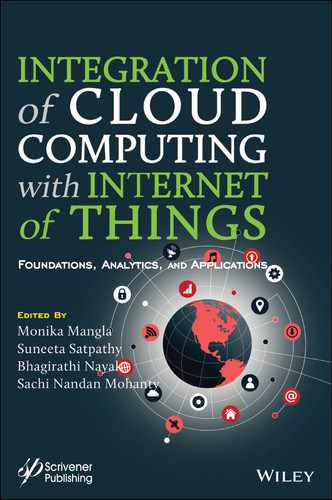Index
- 2FA, 33
- ADC, 81
- Advantages, 5–7, 10–11, 17
- AES and Blowfish encryption, 156
- Agility, 2
- Agriculture, 1–4, 11, 21–22
- Application layer, 202, 208
- Applications of cloud computing, 206–207
- Applications of cloud-based IoT, 208
- Applications of deep learning neural networks, 292
- Architecture, 7–8, 116–122
- Arduino mega, 79
- Artificial intelligence, 1, 9, 20–21
- Artificial neural network, 131, 137
- Attacks in IoT, 45
- Automation, 183, 186, 187, 191, 194
- Campus, 3–4, 7, 22
- Challenges in IoT, 202
- Cloud, 251–263, 266, 268, 269–274
- Cloud computing, 1, 5–6, 9, 203, 319
- view on cloud comptuing and big data, 9–10
- Cloud computing characteristics, 205–206
- Cloud framework, 14
- Cloud IoT, 207
- Cloud IoT in healthcare, 208
- Cloud IoT in logistics, 209
- Cloud provider selection, 301
- Cloud service providers, 335
- Cloud-based IoT architecture, 208
- CNN fuzzy inference engine, 61
- Coding layer, 201
- Cognitive Science, 1, 20–21
- Communicating sequential processes, 156
- Communication network, 1, 17
- Constitution of India, 331
- Convolution neural network, 60–61, 131
- Copyright, 330
- Correspondence in IoT devices, 43
- Cost, 5–9, 11, 13–15, 17, 19
- Cryptojacking, 324
- Cyber security, 322, 328
- Cybernetics, 3
- Data acquition system (DAS), 2
- Data analytics, 251, 252, 258, 263, 265–270, 272, 274
- Data breach, 323
- Data driven, 5
- Data protection bill, 331
- Data redundancy, 202
- Decryption, 320
- Deep learning, 147–149
- Degradation modeling, 1
- Denial of service, 323
- Deployment models of cloud computing, 204
- Device and the location independence, 206
- Device capacity, 202
- Domain specific language, 157
- Industrial revolution, 2
- Industry 4.0, 15–16
- Information technology act, 333
- Infrastructure as a service (IaaS), 205, 252, 253
- Innovations in neural networks,
- Insight of big data and cloud computing, 10
- Intellectual property, 333
- Intelligence, 1, 3–4, 9–10, 20–21
- Intermediary, 335
- Internet of Things, 1, 21–22, 73, 154
- Internet service provider, 335
- Interoperability, 1, 4, 14, 16–20, 22, 327, 338
- IoT architecture, 211
- IoT business & products, 217, 218
- IoT cloud computing technologies, 225
- IoT core, 212–227
- IoT networking, 222
- IoT signal, 1
- IoT technologies, 214
- IoTGC, 12, 13
- IR sensors, 81
- LED, 81
- Liability, 335
- Linear temporal logic, 158
- Literature review, 112–113, 345–348
- Literature survey, 48
- M2M, 15–17
- Machine, 1, 8, 17, 20–21
- Machine learning, 7, 131, 132, 135, 137, 140, 141, 147–149, 251, 258, 266, 271
- Markov model, 8
- MATLAB, 74
- Mean absolute error (MAE), 6
- Mean square error (MSE), 6
- Methodology, 113–116, 349–354
- Microcontroller, 79
- Middleware layer, 202
- Monitoring environment, 209
- MQTT (message queuing telemetry transport), 80, 87
- Multi-layer neural network, 7
- Multi-tenant, 254
- PaaS, 252, 253
- Patent, 333
- PDA, 154
- Pearson’s correlation, 7
- Perception extension system layer, 200
- Perception layer, 201, 208
- Performance analysis, 52
- Perplexing coding, 74
- PIC microcontroller, 161
- PIR, 154
- PIR sensor, 161
- Platform as a service (PaaS), 205
- Policy-based IoT, 3
- Practical application of neural networks using computer codes, 293
- Precision agriculture, 131, 132, 134, 149
- Predictive maintenance, 1
- Principal comopnent analysis (PCA), 6
- Privacy, 329
- Private cloud, 204
- Prognostic health management (PHM), 6
- Prognostics, 5
- Proposed model for attack identification using fog computing, 49
- Public cloud, 204
- Pulse width modulated, 79
- Radio-frequency identification (RFID), 197, 200, 201, 203
- Raspberry Pi, 82, 90
- Real-time traffic, 111–112
- Regression models, 5
- Relevance vector machine, 8
- Reliability, 4, 8, 11
- RFID, 78
- RGB-HSV, 82
- Robust match point algorithm, 77
- ROI, 73
- Root mean squared error (RMSE), 7
- Route break, 202
- RS-232 protocol, 159
- RST, 76
- RUL, 4
- Scalability, 6, 8, 12, 202, 252, 254
- SCM (single chip microcontroller), 89
- Security, 2–5, 6, 8–11, 16–17, 19–20, 22, 203
- Semantic IoT, 1, 13, 19–20
- Sensing layer, 200
- Sensitive personal information, 329
- Sensors, 203
- Service, 251–262, 267–271
- Service layer, 200
- Service models of cloud computing, 204–205
- Service provider, 251, 253, 254, 256, 257, 261, 262, 270
- Smart, 1–4, 7, 11–12, 14–15, 18–22
- Smart healthcare system, 229
- Smart home, 32
- Smart manufactory, 230
- Smart vision framework, 73
- Smartphone, 75
- Socio-ethical, 28, 29
- Software, 251–255, 269, 270
- Software as a service (SaaS), 204, 254
- Standardization, 1, 15, 17
- Structural health monitoring (SHM), 11
- Support vector machine, 131, 132, 138, 140, 147
- Wassenar arrangement, 334
- Wavelet packet transform, 7
- Webcam, 72
- Why study neural networks, 279
- Wi-Fi (wireless-fedilty), 87
- Working of artificial neural networks,
- Workspace, 191
- World Health Organisation, 26
- World intellectual property organisation, 333
- World Wide Web, 25
- WSN (wireless sensor network), 90
..................Content has been hidden....................
You can't read the all page of ebook, please click here login for view all page.
